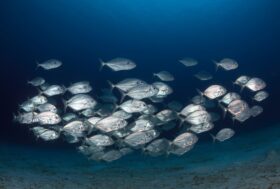Exploring the impact of pedagogy and partnership on curriculum, conservation and attitudes

Since 1988, the curriculum has been a requirement of every school in England. Its earliest aims sought to ‘equip children for a lively and constructive place in society’ and ‘to fit them to do a job of work’ (Callaghan, 1976). Over the last 31 years, the world and the challenges it faces have certainly changed. How then can our curriculum be truly fit for its time?
Most educators would agree that any curriculum should help children to achieve their potential and flourish. Hannon (2017) stresses how schools should aim not only to help children develop a secure sense of self, but also to positively shape themselves, the people and the world around them. In this project, we have considered – through curriculum development – how we can help our young people to ‘thrive’ and take their place in sustaining our global community.
Global wildlife populations have declined 60 per cent in less than half a century, with the vast majority of causes linked to human behaviours such as species exploitation, agriculture and habitat destruction (WWF, 2018). The need to raise awareness of biodiversity and the actions people can take to protect it is recognised in the Aichi Biodiversity Targets of the United Nations (UN) Strategic Plan for Biodiversity (www.cbd.int/sp/targets). This is specifically identified in target 1 which states: ‘By 2020, at the latest, people are aware of the values of biodiversity and the steps they can take to conserve and use it sustainably.’ The UN’s Sustainable Development Goals (https://www.un.org/sustainabledevelopment/sustainable-development-goals/) call for an integrated and global approach to development. Arguably, these goals link action for the environment with our ability to thrive, with explicit goals around quality education.
A reversal of the issues facing our planet requires urgent action from all of us – the children with whom we work included. As a conservation and education charity with a mission of ‘preventing extinction’, Chester Zoo is able to provide schools with the scientific backing, expertise and resources to put these conservation actions at the heart of curriculum planning in a way that adds value and connects individual schools to regional and national campaigns. The urgent nature of the conservation challenge we face presents an opportunity for children to develop their own voice. Conservation requires that they not only learn about issues, but that they also take action and affect change both locally and globally.
Developing a curriculum that enables young people to thrive and meet the global conservation challenges facing our planet was the double challenge given to school leaders participating in the IgniteZoo18 project. How could they design a meaningful curriculum for their school that embraces conservation challenges, whilst also challenging attitudes and reinvigorating pedagogical practice?
Project methodology
Programme content
Over 12 sessions throughout an academic year, colleagues from Ignite TSA and Chester Zoo worked with teachers and leaders from 30 schools to explore pedagogical approaches in order to build a bespoke curriculum.
The project began with presentations from Chester Zoo, illustrating the issues facing wildlife through the lens of its key conservation campaigns. The reality of declining animal populations and habitats was outlined and the obvious sense of building curriculum around these issues became clear. Participants’ attitudes to conservation would be explored pre- and post-project.
Over the following sessions, we explored two key strands of activity. The first brought colleagues together to plan a progression of subject matter within the context of the zoo’s conservation campaigns. Subject leads, department leads and zoo staff came together over a number of sessions to develop coherent plans across each subject discipline.
The second strand was a development of dilemma-led learning by Hywel Roberts and Dr Debra Kidd. Understanding the psychological privilege of stories for the brain (Willingham, 2009), we explored how the power of narrative can be used within the classroom when teaching a conservation curriculum. Again, the impact of both strands would be considered through a post-project questionnaire.
Teachers from all phases attended training around the core concepts of dilemma-led learning over three sessions. They then took this back to their own classrooms and built stories around people, places, problems and possibilities relevant to chosen conservation themes. Layering this approach with appropriate knowledge taught through the curriculum, teachers were able to immerse children into worlds and contexts to enable them to think critically and find a deeper understanding around work they were doing (Roberts and Kidd, 2018).
Using this approach, teachers stepped into the role of a palm oil plantation worker, a family who have lost their home through deforestation, an orangutan who has been separated from its family and a wildlife trafficker. They created stories and challenges for the children to navigate through. Layering essential knowledge into the process, different points of view could be considered in a most powerful way. We explored through the project the impact this had on learning, attitudes and empathy development, as described by Bergland (2013).
The learning from these conservation-focused curricula was shared within and between schools and with the wider community, through exhibition and celebration events at the participating schools, on social media and at a culmination event bringing several of the schools together.
Programme evaluation
Two different survey approaches were used to assess impact.
The first survey explored changes to conservation attitudes and understanding from staff and pupils. This was designed as a repeated measures tool, so that the same questions were asked before and after the project. The survey design included a range of qualitative and quantitative measures, including simple rating scales exploring participants’ connection to nature, the extent to which they felt they could protect endangered species and their attitudes to zoos. Participants were also asked to describe the actions they could take to protect the natural world. Their answers to this more open question were then given a numerical value using a scoring system. More specific answers that represented actions an individual could take were given greater scores than non-specific, more generalised answers.
The second type of survey explored the impact of curriculum development and dilemma-led learning on pupils, leaders and community through the perspective of the project leads. The survey design used simple rating scales asking respondents to rate the impact of the project on different aspects of school life, including impact on teachers, leaders, pupils and the wider community. The data from the leadership survey was analysed using a thematic codingIn qualitative research, coding involves breaking down data ... More process with emergent themes: investment, pedagogy and empathy to action.
Further focus groups and interviews are currently being undertaken and will form the basis of future papers.
Research ethics
Participating students and school staff were fully informed of the research. They had the right to withdraw or not to participate at all. The research was anonymous and used codes rather than names to match pre- and post-tests for the children where applicable. Observations of conservation actions were taken from information freely shared through exhibitions and social media shared by the schools.
Results
Conservation attitudes
In the analysed sample, a small but statistically significant difference was picked up in the increase in student understanding of actions to protect biodiversity, a measure that relates to and suggests a contribution to Aichi Target 1. Across the five-point scale, the average score for students moved from 2.4557 in the student pre-project surveys to 2.6041 post-project (see Figure 1).
Figure 1: Mean student knowledge of actions to protect endangered species scores between pre-survey and post-survey

One of the greater changes was seen in the answers given by the school staff when asked, ‘Do you think that YOU can help protect endangered species?’ The number answering ‘yes’ shifted from 58.95 per cent to 90 per cent between pre- and post-project surveys. When asked to name what actions they could take, as well as citing individual actions, school staff described ‘educating others’ and ‘raising awareness amongst their pupils’, highlighting their understanding of the role of educators in galvanising their pupils into conservation action.
Curriculum impact
From surveys completed by leaders post-project, 100 per cent of participants felt that there was a positive impact on leaders, teachers, pupils and the community. The greatest impact was reported to be on children and teachers. The following themes were identified:
Investment
Participants noted the importance of taking ownership of the curriculum and the agency that this brought for leaders and teachers. Teachers across all schools reported how they themselves were invested in the conservation causes through which the curriculum was planned. This resulted in increased positive attitudes throughout all staff. Schools described how enthusiasm shown by the children and staff was ‘infectious’. One school described how ‘the learning didn’t stop after the project did!’ Others noted, ‘children are talking about palm oil to this day!’
Pedagogy
Leaders described how the dilemma-led learning approach motivated their pupils, allowing them to engage with their learning in a deeper way. They reported staff becoming ‘reinvigorated and energised’ by the process, with several stating that the approach had meant that they ‘had been reminded of why they came into teaching in the first place’. Three schools described a significant impact on teaching and learning as a result of the project. A common theme from this was around improvement in writing. One respondent reported, ‘Children who had previously been reluctant to write were engaging without even realising it, creating posters, campaign leaflets and developing their ability to construct arguments coherently with such enthusiasm.’
Empathy into action
Respondents described pupils’ belief in their ability to make positive changes in the world. They talked about how children were able to see others’ points of view and knew that, dependent on contexts, this wasn’t always easy.
One school reported, ‘Our question was “can we be the change?” They [the children] were, and they knew they were and that was powerful to see.’
Similar responses have been evidenced in the vast majority of schools that took part in the project. Children, staff and whole communities, driven by a deep understanding of conservation issues, have started to take action, which has been quite humbling to see. At the final celebration event, a child told us how at lunchtime, ‘everyone in the hall went mad when they realised there was palm oil in the ice cream’ they’d been served. She went on to say how the children refused to eat it and collectively decided they had to do something. Since that time, the catering company serving the school has committed to using sustainable palm oil only.
Further examples of conservation action taken have included writing to MPs and businesses about the palm oil issues, successfully redeveloping playgrounds to be more wildlife-friendly and creating whole-school exhibitions to raise awareness in their wider school communities. These results were shared widely via social media using the project hashtag #IgniteZoo18, and were also shared at a post-project celebration event. It has not been possible yet, however, to quantify the numbers of conservation actions taken in a more systematic way.
The value of bringing teachers and leaders together to develop curriculum seems clear. Rich curriculum development across all subject areas has been evident, including groups of schools coming together to write and perform conservation-themed songs. The following comment from one headteacher illustrates the impact:
“The project had a truly positive effect on our setting by lifting the staff with their teaching and has given our pupils the platform to really show their passion for conservation. This project will be talked about for years, not just at school but in our wider community.”
Conclusions
The partnership between Ignite TSA, Chester Zoo and participating schools has undoubtedly led to change. At a societal level, schools have demonstrated their ability to encourage conservation action and contribute to global targets. In doing so, and by combining this with pedagogical approaches that enable deeper engagement and the development of empathy, both teachers and pupils have become enthused about their learning and empowered to change the world.
Roberts and Kidd (2018) suggest that a rich curriculum moves beyond knowledge to a place where children know what to do with it. This was evident in the quality of work produced from all schools and the engagement from children and whole communities to take action. Developing a curriculum around such important conservation issues alongside dilemma-led learning approaches has been a powerful mix. Working with Chester Zoo, schools have truly created a rich and broad curriculum and helped children to find their voice for change. We would suggest that this, indeed, is a curriculum fit for its time.
References
Bergland C (2013) The Neuroscience of empathy. In: Psychology Today. Available at: https://www.psychologytoday.com/gb/blog/the-athletes-way/201310/the-neuroscience-empathy (accessed 18 February 2019).
Callaghan J (1976) A rational debate based on the facts. In: Education in England. Available at: http://www.educationengland.org.uk/documents/speeches/1976ruskin.html (accessed 18 February 2019).
Hannon V with Peterson A (2017) Thrive: Schools Reinvented for the Real Challenges We Face. London: Innovation Unit Press.
Oates (2011) Could do better: Using international comparisons to refine the National Curriculum in England. The Curriculum Journal 22(2): 121–150.
Roberts H and Kidd D (2018) Unchartered Territories – Adventures in Learning. Wales: Independent Thinking Press.
Willingham DT (2009) Why Don’t Students Like School? A Cognitive Scientist Answers Questions About How the Mind Works and What it Means for the Classroom. San Francisco, CA: Jossey-Bass.
WWF (2018) Living Planet Report – 2018: Aiming Higher. Grooton M and Almond REA (eds). Gland, Switzerland: WWF.










